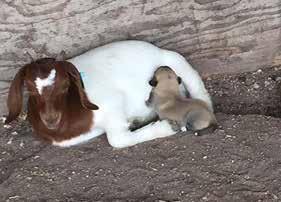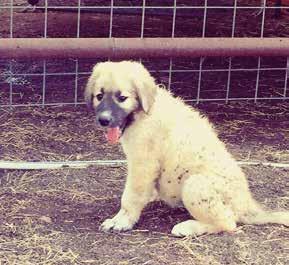
6 minute read
Livestock guardian dogs can ease your worries
from Winter 2020
by legacyiw
Livestock Guardian Dogs
It might appear that Bill Costanzo, Texas A&M AgriLife Research livestock guardian dog specialist, is doing just that each day at the office. However, Costanzo is actually preparing puppies for futures protecting livestock– all while researching the factors that might contribute to that success.
Advertisement
The AgriLife Research Center in San Angelo is conducting a study on what types of bonding pen experiences produce a better livestock guardian dog, or LGD. Bonding pens are fenced pastures where dogs bond with the species of their future charges.
The current class of dogs are Moe, Larry, Curly, Thor, Goliath and Hulk. The puppies will spend approximately three months in the bonding pen process in San Angelo. Each bonding pen is an acre in size and, once the bonding process is complete, the dogs will graduate to much larger pastures where they will guard flocks or herds. They will continue to have their behavior monitored until they are approximately 18 months old.
Dogs as predator deterrents
These dogs serve as deterrents to predators such as coyotes, eagles, feral hogs and mountain lions– anything threatening goats, sheep and their young.
“Bonding of LGDs starts at birth with these animals,” said Costanzo. “ It is believed that if puppies are not properly bonded by 16 weeks of age, the imprinting in the dog’s brain to guard its charges is not firmly set.”
Improper imprinting could result in dogs who wander and do not stay with their charges. Costanzo thinks bonding from birth to 16 weeks of age is probably the single most important thing to do to establish a strong foundation for future success as a livestock guardian dog.
The class of six puppies are in four bonding pens at the AgriLife Research and Extension Center in San Angelo. The dogs are all male and come from two different litters of livestock guardian dogs with proven genetics. Three puppies are Maremma guardian dogs. The other trio is what’s known as a Texas LGD mix of Akbash, Anatolian Shepherd and Great Pyrenees bloodlines.

Studying siblings vs. solo
For this first study there are four bonding pens total, and Costanzo is studying whether these dogs will become better livestock guardian dogs when raised in bonding pens with a sibling or solo. Each trio of brothers is divided up so that one dog is alone in a pen while his two siblings are together in a different bonding pen. Costanzo is also studying whether anti-digging deterrents actually prevent dogs from getting out of fenced areas later in life.
These dogs are not pets, but they are cared for and trained for real-world situations. They are walked on leash-
es a few times a week, groomed and ride in vehicles so they become comfortable traveling between different locations or going to the vet.
“These are dogs that instinctively want to protect, so they need to be bonded to sheep and goats so that natural instinct to guard is focused on the animals, rather than on humans,” said Costanzo.
Species specific again, causing more digestive issues; therefore, it is best to keep a routine of feeding every 12 hours.
The puppies are exposed to both sheep and goats since their future Not only does the routine keep your animals healthy, it helps them gain better. duties could involve protecting both types of animals. “It doesn’t matter the species, animals will always gain more efficiently when there is a routine. For example, if you feed
“LGDs can be bonded to almost any species,” Costanzo said. “They at 7 a.m., and then again at midnight, the animal is hungry for too long. The pH will drop. If they are used to one thing, the digestive system adapts, but if it is a constantly moving target, their digestive system never gets into routine,” Grimes-Hall said. also do a great job when bonded to poultry. Free-range poultry opera In addition to scheduled feeding times, it is imperative to provide your animals with fresh feed at every feeding. Yes, tions in California are using dogs to guard against predators.” high-quality show feed can be costly, and it might seem easy to feed a scoop of the “leftovers” in the pan, but there is proba-
Most likely the puppies will guard the flocks and herds belonging to bly a reason your animal left some behind. Grimes-Hall suggests if your animal isn’t eating the amount you think it should, back AgriLife Research upon graduation. The plan is for two to remain in San off the volume of feed per feeding, then gradually bump up the amount once it starts cleaning up its feed. Angelo, two will work in Menard at the Martin Research Ranch, and two Next, make sure your animal has access to clean, fresh water at all times as water intake is directly and positively correlatwill be at the Sonora Station. The siblings that were in bonding pens together will remain in pairs working together to ed to feed intake and is the most important nutrient for all animals. If you don’t have a free-flowing water system, make sure quantify the impact of bonding with another guardian dog. to clean your buckets daily, so the water your animal is drinking is fresh. Finally, to help make sure your animals keep eating and their digestive tract stays healthy, be sure to provide them a diges-
“There is debate within the LGD breeding community regarding how much interaction with humans is ideal,” said tive supplement like Sure Champ® every day. Look for products that contain Amaferm®, a precision-based prebiotic designed Reid Redden, Ph.D., AgriLife Extension sheep and goat specialist, San Angelo. “Some people prefer that LGD have no to enhance digestibility by amplifying nutrient supply for maximum performance. It is research-proven to increase water and interaction with humans. These dogs often become fearful of humans and are difficult to manage. feed intake. In addition, research shows that Amaferm decreases body temperature in heat-stressed animals.
“Other people prefer that LGD have daily contact with humans. These dogs could bond with people too much and With a these products, you are keeping the good bugs in the gut and keeping the bad bugs out. It could be easy to not stay with their livestock. Through this project and future efforts, we aim to build a data set of rearing LGDs with an overthink this very important step in preparing your show animals, but when you are consistent with your feeding times and array of bonding experiences and document the LGDs effectiveness at guarding livestock.” rations and provide fresh, clean water and the Amaferm advantage, feeding livestock becomes simple.
You can see the puppies’ progress on the LGD Facebook page. On the AgriLife Research and Extension website, you can learn more about the dogs and read Costanzo’s blog.

We’re here for what’s next.
800-237-7193 ext. 10 - sheepandgoatfund.com

The NLPA Sheep and Goat Fund assists the U.S. sheep and goat industries by financing projects that strengthen and enhance the production and marketing of sheep and goats and their products. It is a valuable tool to expand your operation and take it beyond the farm gate. Learn how you can benefit from the fund at sheepandgoatfund.com.
Invest in equipment and business development
Facilitate flock/herd expansion
Improve marketing and product quality

